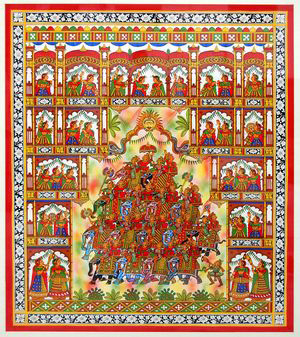In the villages of Rajasthan, as daylight fades and quietly descends, a unique performance captivates villagers when the Bhopa visits. The Bhopa, belonging to the nomadic Rabari tribe, is a singer-performer who traditionally carries painted Phads— horizontal scrolls of hand painted images of local deities—and uses them as mobile temples of folk deities. Drawing from a rich repository of folklore, he, along with his wife the Bhopi, brings the Phad alive—enacting the scene depicted in it while playing a stringed instrument.
In a first-of-its-kind show, Delhi-based arts organisation Art Tree is showcasing an exhibition of these rarely seen Phad paintings. Titled Phad:Mythical Heritage of Bhilwara, the show will include nearly 50 Phad paintings, two of which are rare originals created nearly six decades ago by Bhilwara’s illustrious Phad artist Padmashree Shrilal Joshi. The rest have been painted by the scions of the Joshi family—Kalyan and Gopal Joshi—over last two years.
The exhibition will be on till October 8. The cherry on the cake is that the evenings will come alive with performances by a Bhopa-Bhopi couple of Bhilwara.
Says Pragati Agarwal, Founder, Art Tree and curator of the show: “Phad is a traditional art form more than 700 years old from the Bhilwara/Shahpura region of Rajasthan, known not only for its vibrant colours, but also the fact that it is accompanied by an oral tradition of rendering gatha (folklore). This rendition is performed by Bhopa and Bhopi—priest and his wife from the Rabari tribe. The accompanying instrument is a two string ‘Ravanhatta’. The singing is about the gods, about the heroics of either the local deity Pabuji or Devnarayanji revered by the Gujjar community of camel herders. The Phads, painted like horizontal scrolls with natural colours, also portray folklores, scenes from the Ramayana, and other mythological narratives.”
“Creating a Phad is an act of devotion even as it is an art form,” says Kalyan Joshi of the famed Joshi family that masters the art. “We commence our work with a prayer. Handwoven cloth is soaked overnight so that the threads get thicker. It is then starched, burnished for a smooth and shiny surface and then the Phad painter draws the entire narrative on this canvas. The figures are rounded, wear traditional attire and headgear and bright colours are used to fill them in. The colours are painstakingly extracted from natural sources—stones, flowers, herbs,” he adds.

There was a time when the secrets of Phad painting were confined to the Joshi family. However, when Shrilala Joshi felt that the art form was slowly dwindling away, he felt the need to establish Joshi Kala Kunj (now Chitrashala) in 1960 to develop new artists from outside the Joshi family. He took upon himself the task of revitalising this art, both at national and international level. His sons Kalyan Joshi and Gopal Joshi have carried forward this legacy and have taken upon them the mantle of making this art more relevant in today’s times by introducing new themes and techniques but not compromising on the traditional Phad.
Traditionally, the Bhopas commission the Joshis to make a Phad for them with which they travel and perform. They are mostly called upon to perform in a community if the animals become ill or die. Devotees believe that the Phad is a living temple and hence hold it in spiritual reverence.
The Phad is unique in the manner it is formatted and made. There is a set pattern about how the characters are placed and the colour scheme. Every available inch of the canvas is crowded with figures. Another highlight is the flat construction of the pictorial space. While the figures are harmoniously distributed all over the area, the scale of figure depends on the social status of the character they represent and the roles they play in the story.
Another interesting feature is that the figures in the paintings do not face the audience; rather, they face each other. The illustrations are colour-coded—orange for limbs or torso of figures, yellow for ornaments and general clothing and designs, green for trees and vegetation, brown for architectural structures, red for royal clothing and flags and blue for water and curtains.
An outline of the painting is drawn by the artist with light yellow colour paint; only earth colours or vegetable colours or indigo are used. The colours are then mixed with gum and water and painted one colour after the other, in the order of orange, yellow, and so forth. Black is the last colour paint used for the border. However, traditionally, no gold colour was ever used.
On an auspicious day, the artist signs at the centre of the painting, close to the image of the main deity. Signature of the Bhopa who commissions the painting is also included, but it is optional. As a last act, the artist is said to give 'life' or "awaken the deity" of the painting by opening the pupil in the eyes of the main deity at the centre of the painting. It is now that Phad belongs the Bhopa and not the artist.
The Phad is now a living temple and the Bhopa and Bhopi traverse villages narrating stories which enthral and educate the audience.






